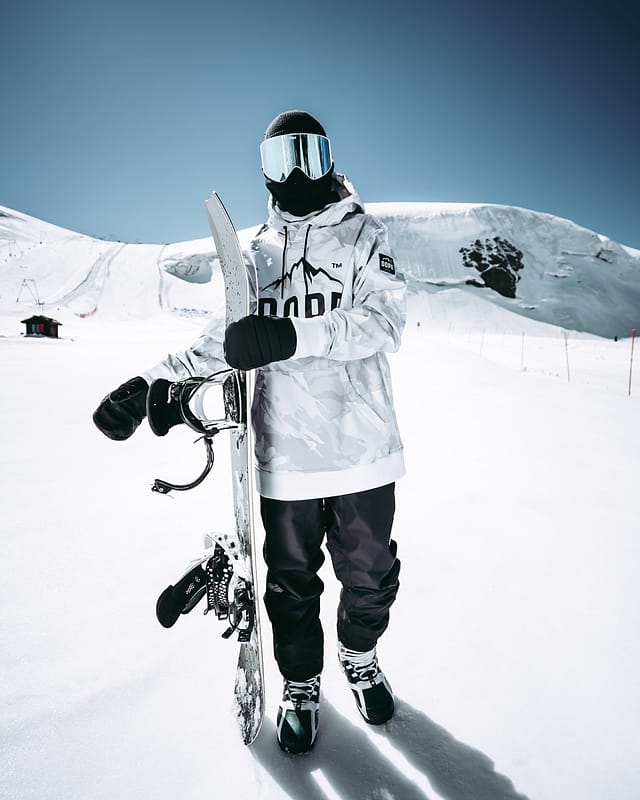The history of snowboarding
When you're strapped into your snowboard at the top of your favourite run with blue skies and fresh snow, do you ever stop and think, what is the history of snowboarding? Well, wonder no more!

How did snowboarding go from a much-hated niche trend into the thrilling one-plank wonder that it is today? Well, we are going to talk you through the first origins of snowboarding; Just how it developed into a well-loved sport. Next time you hit the mountain on your trusty board, you can thank the pioneers and the history of where it came from.
The history of snowboarding is an interesting one, mainly originating in the US, spearheaded by some key figures who essentially ditched their city living to move to the mountains and focus their whole life to developing the sport. There was a lot of dispute on who its founder is, and the sport faced resistance from its skiing counterpart, but eventually, after a short battle, snowboarding was allowed the room to grow into what it is today. For that, we would like to salute the mothers and fathers of snowboarding!
Gear Up for the Adventure: Essential Snowboarding Apparel
Just a little side-note as we delve into the enchanting history of snowboarding: If you're prepping yourself for the thrill of the upcoming season and you're in search of top-quality essentials, we've got you covered! Discover our amazing range of snowboarding jackets and snowboarding pants that combine style with functionality, ready to weather any storm.
The first known history of the snowboard

The first known origins of the mastery that is snowboarding are heavily disputed. Unlike skiing, the battle of who patented the first snowboard is still a constant argument, which mainly comes down to what people consider the first prototypes of a snowboard as an actual snowboard. Complicated? Yes, we agree, it’s a messy old history that is full of opinions, dispute and lots of different types of one-plank boards.
If we take it right back to the late 1800’s, there are stories of Austrian miners riding long wooden boards with a rope or handlebar, presumably to ride down the mountain after a day of work. There were then other significant inventions of a single piece of wood used to navigate through the snow in the Alps. One that stands out, is the Austrian Toni Lenhardt’s monogleider developed in 1900, which even gained enough popularity to be able to host a monogleider contest in 1914.
The dispute over the origins of snowboarding is about what exactly is considered the beginning of modern-day snowboarding; or was it indeed, the beginning of the monoski. Either way, what can’t be argued is that there was a growing desire for a single plank to ride the snow.

The origins of snowboarding
Throughout the early 20th century, there was said to be a few inventions of a mono board that didn’t take off, but there was one that stole the show. Fast forward to Colorado in 1965 and a very snowy Christmas, where Sherman Poppen wanted to give his daughters a new and exciting toy to play on the snow with. He strapped two skis together and called it the snurfer (snow + surf). The snurfer was an absolute hit with his kids and the next thing he knew, all the local children in his area wanted a snurfer. The design developed by adding a rope to the front of the board for balance and steering.
Around the same time in 1963, Tom Sims in the US was a very keen skier and skateboarder as a teenager. He clearly had an interest in inventing and developing skateboard technology from an early age, as he started out fashioning his own skateboards. As a lover of skateboarding but also the snow, he wanted to create a skateboard that he could use in the winter, so along came the skiboard. The skiboard was a long rectangular piece of wood with aluminium sheeting, so he could mimic skateboarding on the snow.

The commercialisation of snowboarding
By the 1970’s the word about snurfing and skiboarding began to spread with some excitement in the US beginning to build, it was now time to start capitalising on these inventions.
Poppen’s snurfer gained popularity throughout the late 1960’s and 70’s, as he actually got the creation patented and began to produce commercially. Around 750 000 snurfers had been sold and this was the first snowboard to be sold properly and actually take off.
Over in Santa Monica, Tom Sims worked in a skateboard shop and whilst being a pro skateboarder, he also continued to develop the skiboard. Sims was contacted by another skiboard developer, Bob Weber and together they brought the Flying Yellow Banana Skiboard to market. They primarily sold into the skateboarding community, which found them success and enough traction to open up some stores.
Throughout this time, there were skiboard and snurfing fans that were trying to help bring the modernisation and acceptance of this new sport. Another significant feature who had a huge part to play was Dimitrije Milovich, a New Yorker who was very keen to get this off the ground. He developed a board that had no ropes, but instead foot straps and fibreglass instead of wood- this is said to be the most rideable snowboard to that date.
Enter Jack Burton (yes, that is the founder of Burton snowboards, he is one of the originals), who at the young age of 14 was bought a snurfer by his parents and he quickly felt the love of the single board trump the skis he had grown up with. The love grew and the passion never faded even when he attempted to live the city life for a while, the mountains still called. He dropped his city life in the 1980’s and headed to Vermont to develop and sell his snowboards, which after a lot of graft, was a huge success.

Modern snowboarding
By the 1980’s, snowboards that were more like the ones we know today, were being wildly sold across the US. It was also increasingly becoming a popular sport amongst those in their late teens and early twenties. Although the old school skiers had yet to recognise it as a sport and there was resistance from the resorts to allow snowboarders on their slopes, they still rode and had a great time.
Vermont in 1982 hosted the first National Snowsurfing Championship, with 125 riders showing up, including Jack Burton and Tom Sims. By 1985 the event grew and became the U.S. Open Snowboarding Championship, which as we know is a huge event that still happens today.
Of course, as the years went by throughout the 1980’s and 90’s, the love for snowboarding grew and the technology of the board itself was modernised (such as the addition of the high back binding). We said goodbye to the snurfer and hello to the contemporary boards by Burton. and Sims.
Although the numbers of snowboarders were rising, they were still shoved into the backcountry areas, made to trek up and shunned off the main slopes and lifts of the resorts. Only the smaller resorts would accept the snowboarders, whilst the larger ones were wary of the insurance increase of snowboarding and not to annoy their loyal skiers. Only 40 resorts allowed snowboarding up until 1985, but by 1990 this increased to 476. By this point, there were found to be 4.3 million snowboarders in the US.

Finally, we see an acceptance of snowboarding as a sport and given the recognition it deserves. By 1998 snowboarding was entered into the Winter Olympics in Nagano and it was a huge hit. By 2002, in the next Winter Olympics, crowds of 30 000 people headed to Park City to watch the incredible, exciting and cool sport and 1 third of all US households watched the events. This was a gamechanger, seeing snowboarding become a loved international sport.
Wrapping up!
So there we have a brief history of snowboarding, which we hope will create a new found respect for your favourite snow sport. The fathers and pioneers sacrificed and used their passion to fight the opposition of a very traditional skiing society. Ultimately, it was the skater boy's laid-back attitude that allowed the original snowboarders to find their place on the mountain. As although, snowboarding isn’t seeped in a long history like skiing, its a younger, fresher version, which reflects the cool kids who choose the one-plank over two.
Related Reading:
- The Best Coworking Spaces For Skiers And Snowboarders
- Snowboard jackets for women / Snowboard pants for women
- 100 Best Ski Resorts In Europe
- Snowboard clothing for men / Snowboard clothing for women
- What To Wear Snowboarding Or Skiing
